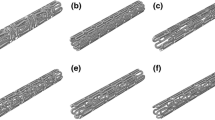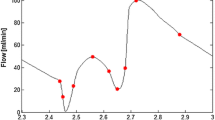Abstract
This study explores the analysis of a new stent geometry from two typical stents used to treat the coronary artery disease. Two different finite element methods are applied with different boundary conditions to investigate the stenosis region. Computational fluid dynamics (CFD) models including fluid–structure interaction are used to assess the haemodynamic impact of two types of coronary stents implantation: (1) type 1—based on a strut-link stent geometry and (2) type 2—a continuous helical stent. Using data from a recent clinical stenosis, flow disturbances and consequent shear stress alterations introduced by the stent treatment are investigated. A relationship between stenosis and the induced flow fields for the two types of stent designs is analysed as well as the correlation between haemodynamics and vessel wall biomechanical factors during the initiation and development of stenosis formation in the coronary artery. Both stents exhibit a good performance in reducing the obstruction artery. However, stent type 1 presents higher radial deformation than the type 2. This deformation can be seen as a limitation with a long-term clinical impact.



















Similar content being viewed by others
References
Antoniadis A, Mortier P, Kassab G, Dubini G, Foin N, Murasato Y, Giannopoulos A, Tu S, Iwasaki K, Hikichi Y, Migliavacca F et al (2015) Biomechanical modeling to improve coronary artery bifurcation stenting: expert review document on techniques and clinical implementation. JACC Cardiovasc Interv 8(10):1281–1296
Bernard S, Bernard E, Barbat T, Albulescu V, Susan-Resiga R (2011) Effects of different types of input waveforms in patient-specific right coronary athereosclerosis hemodynamics analysis. In: Brebbia CA (ed) Modelling in medicine and biology. WitPress, Southampton, pp 55–72
Berry J, Santamarina A, Moore J (2000) Experimental and computational flow evaluation of coronary stents. Ann Biomed Eng 28:386–398
Berry J, Manoach E, Mekkaoui C (2002) Hemodynamics and wall mechanics of a compliance matching stent: in vitro and in vivo analysis. J Vasc Interv Radiol 13:97–105
Chiastra C, Morlacchi S, Gallo D, Morbiducci U, Cárdenes R, Larrabide I, Migliavacca F (2013) Computational fluid dynamic simulations of image-based stented coronary bifurcation models. J R Soc Interface 10(84):20130193
Chiastra C, Migliavacca F, Martínez MÁ, Malvè M (2014) On the necessity of modelling fluid–structure interaction for stented coronary arteries. J Mech Behav Biomed Mater 30(34):217–230
Chua S, MacDonald B, Hashmi M (2002) Finite-element simulation of stent expansion. J Mater Process Technol 120:335–340
Chua S, MacDonald B, Hashmi M (2004) Effects of varying slotted tube (stent) geometry on its expansion behaviour using finite element method. J Mater Process Technol 155–156:1764–1771
Chuong C, Fung Y (1984) Compressibility and constitutive equation of arterial wall in radial compression experiments. J Biomech 17(1):35–40
Dodds S (2002) The haemodynamics of asymmetric stenoses. Eur J Vasc Endovasc Surg 24:332–337
Duraiswamy N, Cesar J, Schoephoerster R (2008) Effects of stent geometry on local flow dynamics and resulting platelet deposition in an in vitro model. Biorheology 45:547–561
Etave F, Finet G, Boivin M, Boyer J, Rioufol G, Thollet G (2001) Mechanical properties of coronary stents determined by using finite element analysis. J Biomech 34(8):1065–1075
Farb A, Burke A, Kolodgie F (2003) Pathological mechanisms of fatal late coronary stent thrombosis in humans. Circulation 108:1701–1706
Fung Y (1967) Elasticity of soft tissues in simple elongation. Am J Physiol 213(6):1532
Fung G, Lam S, Cheng S, Chow K (2008) On stent-graft models in thoratic aortic endovascular repair. A computational investigation of the hemodynamic factors. Comput Biol Med 38:484–489
Gagliardi M (2012) Relevance of mesh dimension optimization, geometry simplification and discretization accuracy in the study of mechanical behaviour of bare metal stents. In: Gangopadhyay A (ed) Innovations in data methodologies and computational algorithms for medical applications. University of Maryland Baltimore County (UMBC), USA, p 15
Giddens D, Zarins C, Glagov S (1990) Response of arteries to near wall fluid dynamic behaviour. Appl Mech Rev 43(2):98–102
Glagov S, Weisenberg E, Zarins C (1987) Compensatory enlargement of human atherosclerotic coronary arteries. N Engl J Med 316:1371–1375
Gundert TJ (2011) Improving cardiovascular stent design using patient-specific models and shape optimization. Master's Theses (2009-), Milwaukee. http://epublications.marquette.edu/theses_open/128
Hashimoto T, Meng H, Young W (2006) Intracranial aneurysms: links among inflammation, hemodynamics and vascular remodeling. Neurol Res 28:372–380
Herzog C, Zwrner P, Doll J, Nielsen C, Nguyen S, Savino G, Vogl T, Costello P, Schoepf U (2007) Significant coronary artery stenosis: comparison on per-patient and per-vessel or per-segment basis at 64-section CT angiography. Radiology 244(1):112–120
Holzapfel G (2000) Nonlinear solid mechanics: a continuum approach for engineering. Wiley, p 470. ISBN: 978-0-471-82319-3
Holzapfel G, Gasser T, Ogden R (2000) A new constitutive framework for arterial wall mechanics and a comparative study of material models. J Elast 61:1–48
Joel M, Anburajan M (2013) 3D Modeling of stenotic internal carotid artery treated with stent: a CFD analysis of blood. In: International Conference on Computer, Networks and Communicattion Engineering (ICCNCE)
Jung H, Choi J, Park C (2004) Asymmetric flows of non-Newtonian fluids in a symmetric stenosed artery. Korea-Aust Rheol J 1(16):101–108
Kajzer W, Kackmarek M, Marciniak J (2005) Biomechanical analysis of stent–oesophagus system. J Mater Process Technol 162–163:196–202
Kamiya A, Togawa T (1980) Adaptive regulation of wall shear stress to flow change in the canine carotid artery. Am J Physiol 239:14–21
Katritsis D, Kaiktsis L, Chaniotis A (2007) Wall shear stress: theoretical considerations and methods of measurement. Prog Cardiovasc Dis 49:307–329
Kim H, Vignon-Clementel I, Coogan J, Figueroa C, Jansen K, Taylor C (2010) Patient-specific modeling of blood flow and pressure in human coronary arteries. Ann Biomed Eng 38(10):3195–3209
Ku D, Giddens D, Zarins C (1985) Pulsatile flow and atherosclerosis in the human carotid bifurcation. Positie correlation between plaque location and low oscillating shear stress. Arteriosclerosis 5:293–302
LaDisa J, Hettrick D, Olson L (2002) Stent implantation alters coronary artery hemodynamics and wall shear stress during maximal vasodilation. J Appl Physiol 93:1939–1946
LaDisa J, Guler I, Olson L (2003) 3D computational fluid dynamics modeling of alterations in coronary wall shear stress produced by stent implantation. Ann Biomed Eng 31:972–980
LaDisa J, Olson L, Guler I, Hettrick D, Kersten J, Warltier D, Pagel P (2005) Circumferential vascular deformation after stent implantation alters wall shear stress evaluated with time-dependent 3D computational fluid dynamics models. J Appl 98:947–957
LaDisa J, Olson L, Hettrick D, Warltier D, Kersten J, Pagel P (2006) Alterations in regional vascular geometry produced by theoretical stent implantation influence distributions of wall shear stress: analysis of a curved coronary artery using 3D computational fluid dynamics modeling. Biomed Eng Online 5(40)
Lally C, Dolan F, Prendergast P (2005) Cardiovascular stent design and vessel stresses: a finite element analysis. J Biomech 38:1574–1581. doi:10.1186/1475-925X-5-40
Masson I, Boutouyrie P, Laurent S, Humphrey J, Zidi M (2008) Characterization of arterial wall mechanical behavior and stresses from human clinical. J Biomech 41(12):2618–2627
Mates R, Gupta A, Bell A, Klocke F (1978) Fluid dynamics of coronary artery stenosis. Circ Res 42:152–162. doi:10.1161/01.RES.42.1.152
Migliavacca F, Petrini L, Montanari V, Quagliana I, Auricchio F, Dubini G (2005) A predictive study of the mechanical behaviour of coronary stents by computer modelling. Med Eng Phys 27:13–18
Migliavacca F, Chiastra C, Chatzizisis Y, Dubini G (2015) Virtual bench testing to study coronary bifurcation stenting. EuroIntervention 11:31–34
Morbiducci U, Ponzini R, Grigioni M, Redaelli A (2007) Helical flow as fluid dynamic signature for atherogenesis in aortocoronary bypass. A numeric study. J Biomech 40:519–534. doi:10.1016/j.jbiomech.2006.02.017
Mortier P, Wentzel J, De Santis G, Chiastra C, Migliavacca F, De Beule M, Louvard Y, Dubini G (2015) Patient-specific computer modelling of coronary bifurcation stenting: the John Doe programme. Eurointervention 11(V):35–39
Murphy J, Boyle F (2007) Comparison of stent designs using computational fluid dynamics. In: 10th Annual Sir Bernard Crossland Sysmposium
Patel D, Fry D (1969) The elastic symmetry of arterial segments in dogs. Circu Res 24(1):1–8
Raghavan M, Vorp D (2000) Toward a biomechanical tool to evaluate rupture potential of abdominal aortic aneurysm: identification of a finite strain constitutive model and evaluation of its applicability. J Biomech 33(4):475
Schuessler A, Piper M (2004) Boundaries for the use of nitinol in medical applications. In: Proceedings of the International Conference on Shape Memory and Superelastic Technologies, Baden-Baden
Sioglas P, Papafaklis M, Sakellarios A, Stefanou K, Bourantas C, Athanasiou L, Exarchos T, Naka K, Michalis L, Parodi O, Fotiadis D (2015) Patient-specific simulation of coronary artery pressure measurements: an in vivo 3D validation study in humans. Biomed Res Int. doi:10.1155/2015/628416
Stehbens W (1987) Etiology of intracranial berry aneurysms. J Neurosurg 6(70):823–831
Tambaca J, Canic S, Kosor M, Fish R, Paniagua D (2011) Mechanical behavior of fully expanded commercially available endovascular coronary stents. Tex Heart Inst J 5(38):491–501
Torii R, Wood N, Hadjiloizou N, Dowsey A, Wright A, Hughes A, Davies J, Francis D, Mayet J, Yang G, Thom S, Yun X (2008) Differences in coronary artery hemodynamics due to changes in flow and vascular geometry after percutaneous coronary intervention. Heart 94:A1–A4
Vorp D, Rajagopal K, Smolinski P, Borovetz H (1995) Identification of elastic properties of homogeneous, orthotropic vascular segments in distension. J Biomech 28(5):501–512
Zamir M, Sinclair P, Wonnacott T (1992) Relation between diameter and flow in major branches of the arch of the aorta. J Biomech 25(11):1303–1310
Zierler R, Summer D (2010) Arterial physiology. In: Vascular surgery. Elsevier, Philadelphia, p Chapter 9
Acknowledgments
This research was funded by the Portuguese Foundation for the Science and Technology (FCT) through the Doctoral Grant—SFRH/BD/68293/2010 of the first author. Also thanks to CEris (Civil Engineering Research and Innovation for Sustainability) of the Department of Civil Engineering, Architecture and Georesources, Instituto Superior Técnico (IST), University of Lisbon (ULisbon).
Author information
Authors and Affiliations
Corresponding author
Rights and permissions
About this article
Cite this article
Simão, M., Ferreira, J.M., Mora-Rodriguez, J. et al. Behaviour of two typical stents towards a new stent evolution. Med Biol Eng Comput 55, 1019–1037 (2017). https://doi.org/10.1007/s11517-016-1574-x
Received:
Accepted:
Published:
Issue Date:
DOI: https://doi.org/10.1007/s11517-016-1574-x




